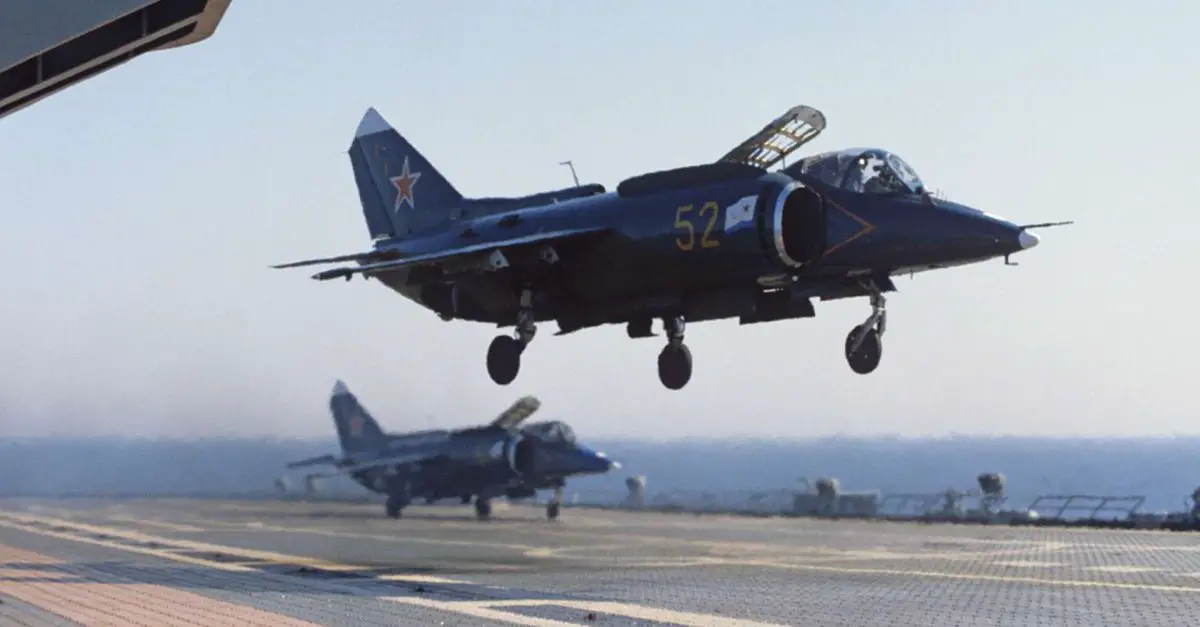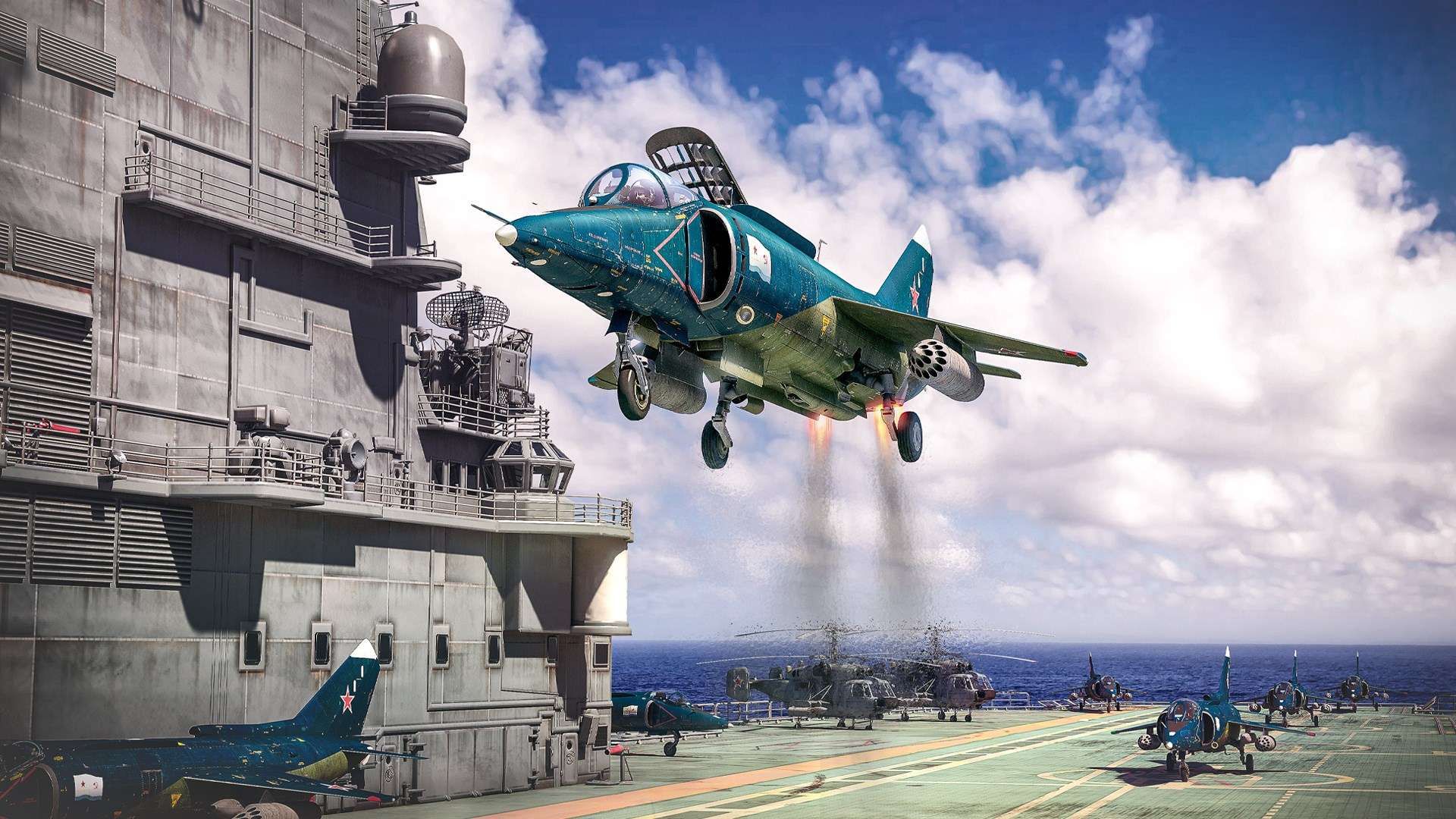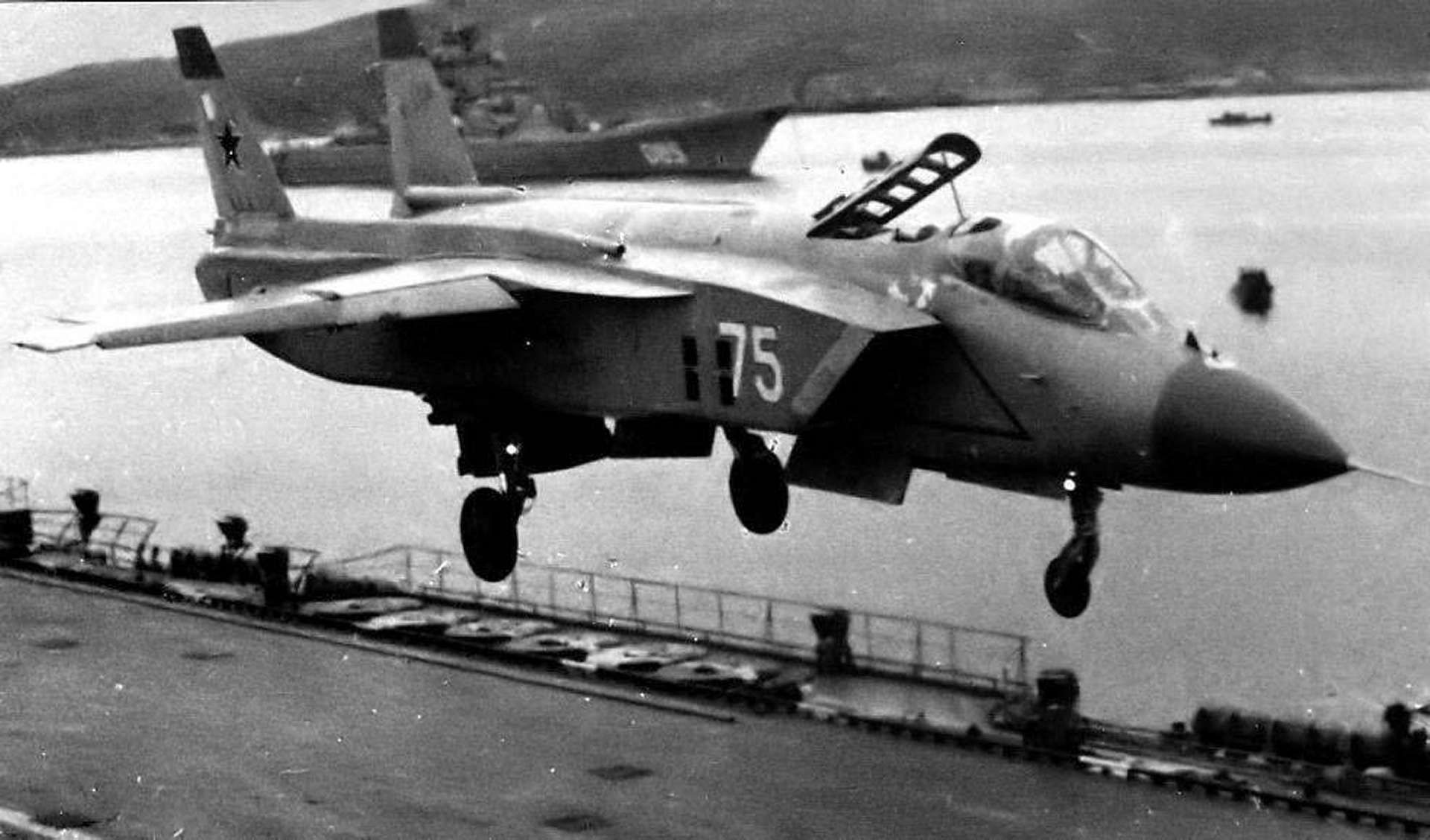Breaking News
Yakovlev ready to develop a fifth-generation VTOL aircraft for Russia.
On July 27, 2024, the Russian aircraft manufacturer Yakovlev, part of the United Aircraft Corporation Rostec, is set to resume its efforts in developing vertical takeoff and landing (VTOL) aircraft, advancing to the fifth generation. Andrey Boginsky, the Deputy General Director of UAC for Civil Aviation and General Director of PJSC Yakovlev, announced that Yakovlev is prepared to undertake this project if requested by the Ministry of Defense. He noted that Yakovlev has maintained and expanded its extensive experience in VTOL aircraft development over the past 60 years, enabling swift implementation of new advancements.
Follow Army Recognition on Google News at this link

Designed for use on smaller Soviet aircraft carriers like the Kiev-class ships, the Yak-38 utilized a propulsion system with two lift jets behind the cockpit for vertical takeoff and landing, and a single vectored-thrust engine for horizontal flight. (Picture source: Russian social media)
The development of vertical takeoff and landing (VTOL) in Russia began 60 years ago. On July 27, 1964, test pilot V.G. Mukhin performed the first flight of the Yak-36, an aircraft developed by the A.S. Yakovlev Design Bureau. This prototype, which conducted its initial runway-style takeoff on that day, later achieved its first free hover and transition to horizontal flight on September 27, 1964. The first full-profile flight, involving vertical takeoff and landing, occurred on March 24, 1966. The Yak-36 gained international attention in July 1967 during the air parade in Domodedovo, showcasing its vertical takeoff and landing capabilities.
The Yakovlev Yak-36, also known as the "Freehand," was an experimental VTOL (Vertical Take-Off and Landing) aircraft developed by the Soviet Union in the early 1960s. It was designed to test the feasibility and practicality of VTOL operations, utilizing two Rybinsk RD-36-35FV turbojet engines with vectorable nozzles. These engines allowed the aircraft to perform vertical takeoffs and landings, a capability that was demonstrated successfully during its test flights starting in 1963.
Featuring two R-27 lift-cruise engines, the Yak-36 had a maximum speed of approximately 900 km/h and a service ceiling of 12,000 meters. Its operational range was around 370 kilometers, which was limited by the high fuel consumption associated with its VTOL capabilities and its takeoff weight of 9,400 kg. The aircraft was equipped with basic armament options, including 23mm cannons and various rockets and bombs, although its primary function was not combat but rather technological experimentation and data collection.
The Yak-36 did not progress beyond the experimental stage and was primarily used to gather data that would inform the development of future Soviet VTOL aircraft. Only four prototypes were built, serving as testbeds for various design solutions, piloting techniques, and operational methods. Despite the Yak-36's limitations, such as engine reliability issues and limited payload capacity, it provided valuable insights into VTOL technology for the USSR, as the Yak-36's design included rotating nozzles, a jet-jet control system, and automatic flight control in near-zero conditions.

The Yak-36 did not progress beyond the experimental stage and was primarily used to gather data that would inform the development of future Soviet VTOL aircraft. (Picture source: Russian social media)
Building on the experience from the Yak-36, the Yakovlev Design Bureau created the Yakovlev Yak-38, NATO reporting name "Forger," the Soviet Union's first operational vertical/short takeoff and landing (VTOL) aircraft. The Yak-38's first full-profile flight occurred on February 25, 1972. That same year, the Yak-38 made history by landing on the aircraft carrier Moskva, becoming the first Soviet aircraft to do so, before entering into service within the USSR Navy in 1976. Designed for use on smaller Soviet aircraft carriers like the Kiev-class ships, the Yak-38 utilized a propulsion system with two lift jets behind the cockpit for vertical takeoff and landing, and a single vectored-thrust engine for horizontal flight. This configuration enabled operations from short runways but resulted in high fuel consumption and limited range, reducing overall combat endurance and payload capacity compared to Western counterparts such as the Harrier.
The Yak-38 had a maximum speed of around 800 km/h (500 mph) and could carry armaments including R-60 air-to-air missiles, Kh-23 air-to-surface missiles, bombs, and unguided rockets. Its lack of radar restricted its effectiveness in air-to-air combat, relegating it mainly to ground attack roles. Key variants included the Yak-38M, which had more powerful Tumansky R-28V-300 engines, external fuel tanks, and an improved steerable nose landing gear, as well as the Yak-38U, a two-seat trainer model. These variants aimed to enhance operational range and payload capacity while providing necessary training capabilities for Soviet pilots.
The Yak-38 saw limited operational use and faced significant challenges, including high maintenance demands and difficulties in harsh environments like Afghanistan. Its VTOL capability was constrained by high fuel consumption during takeoff and landing, which affected mission endurance. Despite these issues, the Yak-38 contributed to the development of Soviet VTOL technology. However, its effectiveness was limited, leading to its eventual phase-out in favor of more advanced aircraft following the dissolution of the Soviet Union.

Designed for use on smaller Soviet aircraft carriers like the Kiev-class ships, the Yak-38 utilized a propulsion system with two lift jets behind the cockpit for vertical takeoff and landing, and a single vectored-thrust engine for horizontal flight. (Picture source: Russian social media)
The pinnacle of the Yakovlev Design Bureau's VTOL aircraft development was the Yak-141, the world’s first supersonic VTOL aircraft, achieving speeds up to Mach 1.7. The Yakovlev Yak-141, also known as the Yak-41M, was developed by the Soviet Union as a VTOL (Vertical Take-Off and Landing) aircraft for the Soviet Navy's Kiev-class carriers. It was designed to surpass the capabilities of the Yak-38 and to compete with aircraft like the British Harrier. The Yak-141 featured a tri-engine configuration: a main RD-41 afterburning turbofan engine and two RD-38 lift engines, which allowed for smooth transitions between vertical and horizontal flight.
For its time, the Yak-141 incorporated the latest scientific and technical advancements in both airframe design and the choice of weapons and equipment. Its advanced control system automated almost all flight modes, synchronized engine operations, enabled remote control along the longitudinal channel, and stabilized movement through the "boost" of the lift-cruise and lift engines. These innovations simplified the piloting process during takeoff and landing.
The Yak-141 was also equipped with a multi-target tracking radar, enhancing its capabilities in air-to-air combat by enabling the engagement of multiple targets simultaneously. The aircraft's armament included air-to-air missiles, guided bombs, and a cannon, making it suitable for various combat roles, from air superiority to ground attack. Its structural design incorporated advanced materials to support its high-speed and VTOL capabilities, ensuring durability and performance in demanding naval operations.
The Yak-141 made its first flight on March 9, 1987, and test pilot A.A. Sinitsyn set 12 world records with it. Despite the creation of four prototypes and its innovative design, the Yak-141 project was halted in 1992 due to funding cuts following the dissolution of the Soviet Union, but not before Yakovlev entered into a partnership with Lockheed Martin, allowing some of the Yak-141's technologies to influence the development of the U.S. F-35 Joint Strike Fighter.

Following the creation of the Yak-38, the Yakovlev Design Bureau developed the Yak-141, the world’s first supersonic VTOL aircraft, which achieved speeds of up to Mach 1.7. (Picture source: Russian social media)
In 2018, during the Army forum, Deputy Prime Minister Yuri Borisov (now head of Roscosmos) revealed that work on a new VTOL aircraft began in 2017 under the state armament program. He noted that the development timeframe, determined by the technological cycle, ranges from 7 to 10 years. This new aircraft is anticipated to be integral to the Russian Navy's carrier-based aviation. Although Borisov did not specify the design bureau involved, the industry recognizes Yakovlev's unique experience and capabilities in VTOL development.
On July 27, 2024, Andrey Boginsky reiterated Yakovlev's readiness to resume VTOL development, emphasizing the company's historical and technical expertise. He mentioned that the design bureau began working on VTOL aircraft in the late 1950s, recalling the Yak-38 and Yak-141 as notable milestones. Boginsky highlighted that new aviation technologies, combined with preserved scientific and technical groundwork from the 1990s, enable a rapid return to VTOL aircraft creation if the Ministry of Defense assigns the task.
The Russian expert community suggests that VTOL aircraft may be crucial not only for the Navy but also for the Aerospace Forces, especially in scenarios where base airfields face threats from massive missile and bomb attacks from Ukraine. Developing such an aircraft entails overcoming significant challenges, including miniaturizing avionics, creating new generation avionics, designing a specialized glider and wing, and most critically, developing a powerful and reliable engine. Notably, VTOL aircraft could be utilized on various ships and in land-based versions on small sites without runways, without waiting for new aircraft carriers.
However, the feasibility of creating a VTOL aircraft for the Russian Aerospace Forces warrants careful consideration, especially given the rapid advancements in unmanned aviation. The complexity and high costs of VTOL aircraft development, requiring powerful engines with rotating nozzles, pose significant financial challenges. Furthermore, the recent military operations in Ukraine have highlighted the effectiveness of attack drones, which have surpassed traditional frontline bombers in efficiency. Given the high cost and vulnerability of manned aircraft to modern air defense systems, the immediate need for a new manned VTOL attack aircraft is debatable.
Currently, the Russian Aerospace Forces actively deploy Su-35S, Su-30SM, and Su-57 fighters in Ukraine. Despite air superiority, the strike potential of these aircraft is limited by the risk of losing skilled pilots and expensive aircraft to enemy air defenses. In this context, the development of unmanned aircraft utilizing artificial intelligence appears more rational. Attack UAVs, besides being cost-effective, offer significant advantages, including the ability to operate in high-risk areas without endangering pilots and delivering precise strikes deep behind enemy lines. In light of the increasing prominence of unmanned aircraft, the strategy for developing fighter aircraft may need to prioritize the advancement of attack UAVs over new manned VTOL aircraft, according to some Russian experts.

Lift fans, as seen in the Yak-141 and the F-35B, involve lifting fans located in large holes in an otherwise conventional fixed wing or fuselage, providing lift during VTOL operations and transitioning to fixed-wing lift in forward flight. (Picture source: Russian social media)
In the military aviation industry, VTOL aircraft have drawn attention due to their design complexity, innovation, and ability to operate from confined spaces such as ships or airfields with short runways. VTOL aircraft can take off and land vertically without a runway, encompassing helicopters, thrust-vectoring fixed-wing aircraft, and hybrids with powered rotors such as cyclogyros, cyclocopters, and gyrodynes. These aircraft can operate in various modes, including conventional take-off and landing (CTOL), short take-off and landing (STOL), or short take-off and vertical landing (STOVL).
Various designs have been developed to achieve powered lift in VTOL aircraft, each with unique mechanisms to enable vertical takeoff and landing. One design is the convertiplane, which takes off under rotor lift like a helicopter and then transitions to fixed-wing lift in forward flight. The Bell Boeing V-22 Osprey is a prominent example of this approach. The tiltrotor concept, as seen in the V-22 Osprey, involves tilting its propellers or rotors vertically for VTOL and then forward for horizontal flight while keeping the main wing fixed in place. Similarly, tilting ducted fans, like those in the Bell X-22, use a comparable concept but with ducted fans instead of exposed rotors.
The tiltwing design involves tilting the entire wing and its attached propellers or rotors to transition between vertical and horizontal flight. Tail-sitter designs, such as the Ryan X-13 Vertijet, sit vertically on their tails for takeoff and landing before tilting forward for horizontal flight. Thrust vectoring, utilized in aircraft like the Harrier and F-35B, involves varying the direction of the engine exhaust between vertical and horizontal thrust, enabling the aircraft to achieve vertical takeoff and landing. Other designs include tiltjets, which are similar to tiltrotors but use turbojet or turbofan engines instead of propellers.
Lift jets, as used in the Yak-38, provide auxiliary lift for VTOL operation and can be shut down for normal wing-borne flight. Lift fans, as seen in the F-35B, involve lifting fans located in large holes in an otherwise conventional fixed wing or fuselage, providing lift during VTOL operations and transitioning to fixed-wing lift in forward flight. Some experimental aircraft have also utilized the Coandă effect, redirecting airflow along a surface to achieve lift, with notable examples being the Avro Canada VZ-9 Avrocar.


























